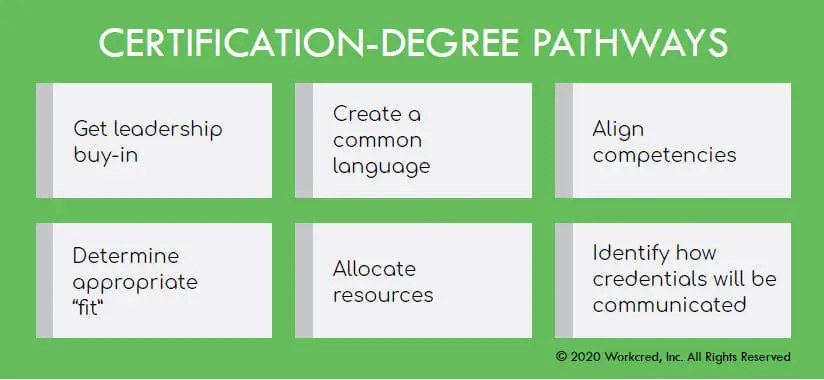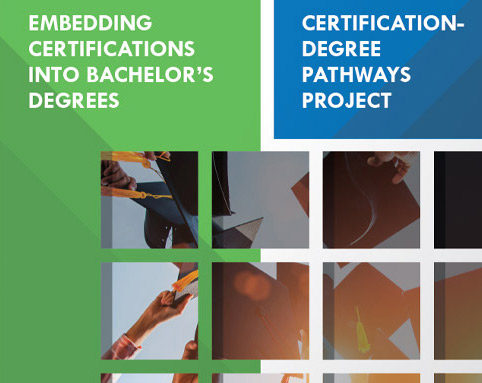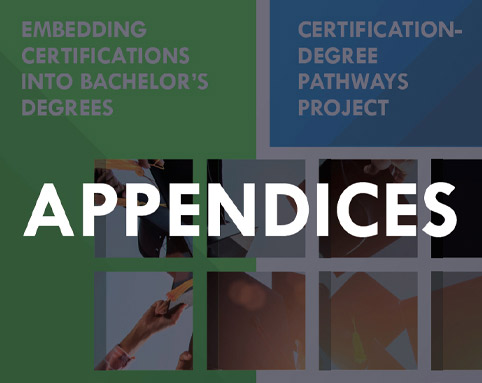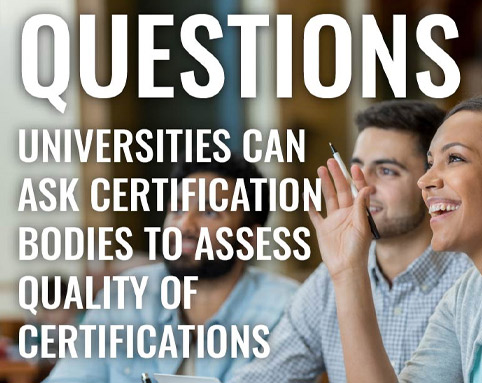There is a lack of understanding in the workforce of the different types of credentials and how they can work together to improve student success and employability outcomes―including higher salaries,
improved rates of hire, and faster promotion tracks. Certifications can be used to enhance a college education with specific skills needed by employers, resulting in students earning a certification while pursuing their degree or
earning a certification at the end of their degree program, achieving a more comprehensive education. Certifications within degrees may also increase students’ chances for summer employment and work-based learning
experiences during the academic year, as well as lead to promotions and wage increases prior to, or as students complete, their degree. Degree programs can further provide security to students when combined with earning a
certification that is valued in the labor market, and provide bachelor’s degree students with an opportunity to demonstrate and apply what they have learned in their academic programs.
See other related certification-degree pathway work:
“Public research universities are committed to improving the workforce outcomes of their students and to addressing the workforce needs of local economies. This approach can ensure students that their credentials will
have value to the labor market, and it can ensure employers that graduates have the skills required to perform in the workplace.”
-Sheila Martin
vice president for economic development and community engagement at APLU
To this end, Workcred — in partnership with the Association of Public and Land-grant Universities (APLU), the Coalition of Urban Serving Universities (USU), and the University Professional and Continuing Education Association (UPCEA) — brought together representatives of universities and certification bodies from across the U.S. to identify opportunities and solutions to barriers of embedding certifications into bachelor’s degree programs in the growing fields of healthcare, cybersecurity, manufacturing, and the liberal arts.
This collaborative, nationwide initiative culminated in the development of a framework to develop and scale certification-degree pathways.
Learn more about the elements of the framework.

The framework outlines the elements associated with integrating industry certifications into bachelor’s degrees, leading to the development of a successful certification-degree pathway. The framework can be used by certification bodies and universities to test different strategies and practices to better align certification and degree programs. The framework is designed to be accessible to and used by all students — especially those historically underserved. Each pathway would incorporate the individual elements identified in the framework:
- obtaining and sustaining leadership buy-in,
- creating a common language,
- aligning certification exam competencies and academic course and program learning outcomes,
- determining the appropriate fit for a certification within an academic program,
- allocating resources, and
- identifying how credentials will be shared with external audiences such employers.
The framework will be used to test the different models and practices that better align certifications and degrees.
“Aligning our curriculum with different certifications has been extremely beneficial. Students can earn a certification from a nationally-recognized organization which is important when entering the job market, and there’s
quality assurance that our curriculum meets standards within that profession.”
-Dr. Valerie Wayda
associate dean for undergraduate and academic affairs in the College of Physical Activity and Sport Sciences at West Virginia University
Resources

If after viewing the framework you have any feedback on the content of the report, examples of a certification-degree pathway, or ideas on how to shape future phases of this work, please let us know.

Embedding Certifications into Bachelor’s Degrees Certification-Degree Pathways Project

To Align or Embed with Academic Programs
